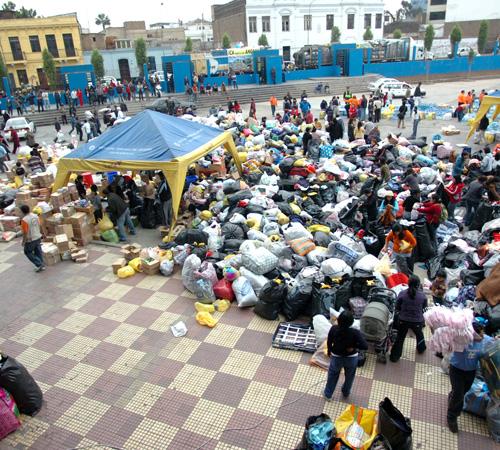Survivors of deadly Peru quake seek relief

Aug 17, 2007
Last updated on May 12, 2016 at 02:41 p.m.
PISCO, Peru – The names of the dead were freshly painted in black on headstones in this southern port city razed by a powerful earthquake, as at least two strong aftershocks on Friday rattled the region.
Survivors of Wednesday’s magnitude-8 quake lined up under a beating sun in Pisco’s central plaza to receive bottled water unloaded from trucks by soldiers.
Brig. Maj. Jorge Vera, chief of the rescue operation, said 85 percent of downtown Pisco was destroyed in the quake, which killed at least 510 people and sent a church’s soaring ceiling tumbling down on hundreds of worshippers. The center of the city was choked with traffic, including relief vehicles.
“The biggest problem is that Pisco practically no longer exists. Everything is destroyed. It has practically been razed,” Julio Franco, chief of operations in Pisco for a Spain-based NGO called Firefighters without Borders, told Cadena Ser radio.
Get The Daily Illini in your inbox!
The relief effort showed signs of organization by mid-morning, with the military clearing rubble, police identifying corpses and civil defense teams ferrying food. Housing ministry officials started to assess who will need new homes.
“Nobody is going to die of hunger or thirst,” President Alan Garcia said following complaints that aid was not arriving fast enough for thousands who lost loved ones, homes and belongings in Wednesday’s temblor.
At least two aftershocks, including a magnitude-5.9 quake, rattled the area on Friday.
“In 10 days, we’ll have a situation approaching normality,” said Garcia, though he acknowledged that rebuilding the hard-hit southern coastal region would take far longer.
In the cemetery, a man painted the names of the dead in black on headstones. Some 200 headstones were lined up, along with more than 30 coffins. Burial vaults collapsed in the quake, and crosses tumbled over.
On Thursday, distraught relatives wept as they searched grim rows of body bags for loved ones killed when the church ceiling came down.
Peru’s fire department said late Thursday the death toll from the quake had risen to 510, and rescuers were still digging through rubble from collapsed adobe homes in cities and hamlets.
Destruction was centered in Peru’s southern desert, the oasis city of Ica and nearby Pisco, about 125 miles southeast of the capital of Lima.
Searchers at Pisco’s San Clemente church pulled out at least 60 bodies by late Thursday. More than 1,500 were injured in the quake-hit region.
Hundreds had gathered in the pews of the San Clemente church on Wednesday – the day Roman Catholics celebrate the Virgin Mary’s rise into heaven – for a special Mass marking one month since the death of a Pisco man.
With minutes left in the Mass, the church’s ceiling began to break apart. The shaking lasted for an agonizing two minutes, burying 200 people, according to the town’s mayor. Only two stone columns and the church’s dome rose from a giant pile of stone, bricks, wood and dust.
One man shouted at the bodies of his wife and two small daughters as they were pulled from the rubble: “Why did you go? Why?”
As dusk fell, Health Minister Carlos Vallejos said finding survivors seemed increasingly unlikely.
Felipe Gutierrez, 82, sat in his pajamas – his only clothing – in front of what was his Pisco home. The quake reduced it to rubble and he, his 74-year-old wife, their two children and three grandchildren sat staring at the ruins, a tangle of adobe, straw and all of their belongings.
“Yesterday we slept on a mattress, and now we’ll have to set up a tent, because we have no where to live,” he said.
Garcia flew by helicopter to Ica, a city of 120,000 where a quarter of the buildings collapsed, and declared a state of emergency.
Government doctors called off their national strike for higher pay to handle the emergency.
International help includes cash from the United States, United Nations, Red Cross and European Union as well as tents, water, medicine and other supplies. The U.S. Navy hospital ship Comfort, equipped with a staff of 800 and 12 operating rooms, is in Ecuador and could quickly sail to Peru if asked, U.S. officials said.
Sean McCormack, a State Department spokesman, said an American medical team had been on a training mission in the area at the time of the quake, and its members have now split up to and are working with local authorities to assist.
Electricity, water and phone service were down in much of southern Peru. Rescue convoys were slowed by giant cracks and fallen power lines on the Panamerican Highway.
In Chincha, a small town near Pisco only 25 miles from the quake’s epicenter, an AP Television News cameraman counted 30 bodies in a hospital patio. The face of one victim was uncovered, her eyes open. The feet of another stuck out from under a blanket.
Scientists said the quake was a “megathrust” – a type of earthquake similar to the catastrophic Indian Ocean temblor in 2004 that generated deadly tsunami waves. “Megathrusts produce the largest earthquakes on the planet,” USGS geophysicist Paul Earle said.
In general, magnitude 8 quakes are capable of causing tremendous damage. Quakes of magnitude 2.5 to 3 are the smallest generally felt, and every increase of one number on the magnitude scale means that the quake’s magnitude is 10 times as great.
The temblor occurred in one of the most seismically active regions in the world at the boundary where the Nazca and South American tectonic plates meet. The plates are moving together at a rate of 3 inches a year, Earle said.





